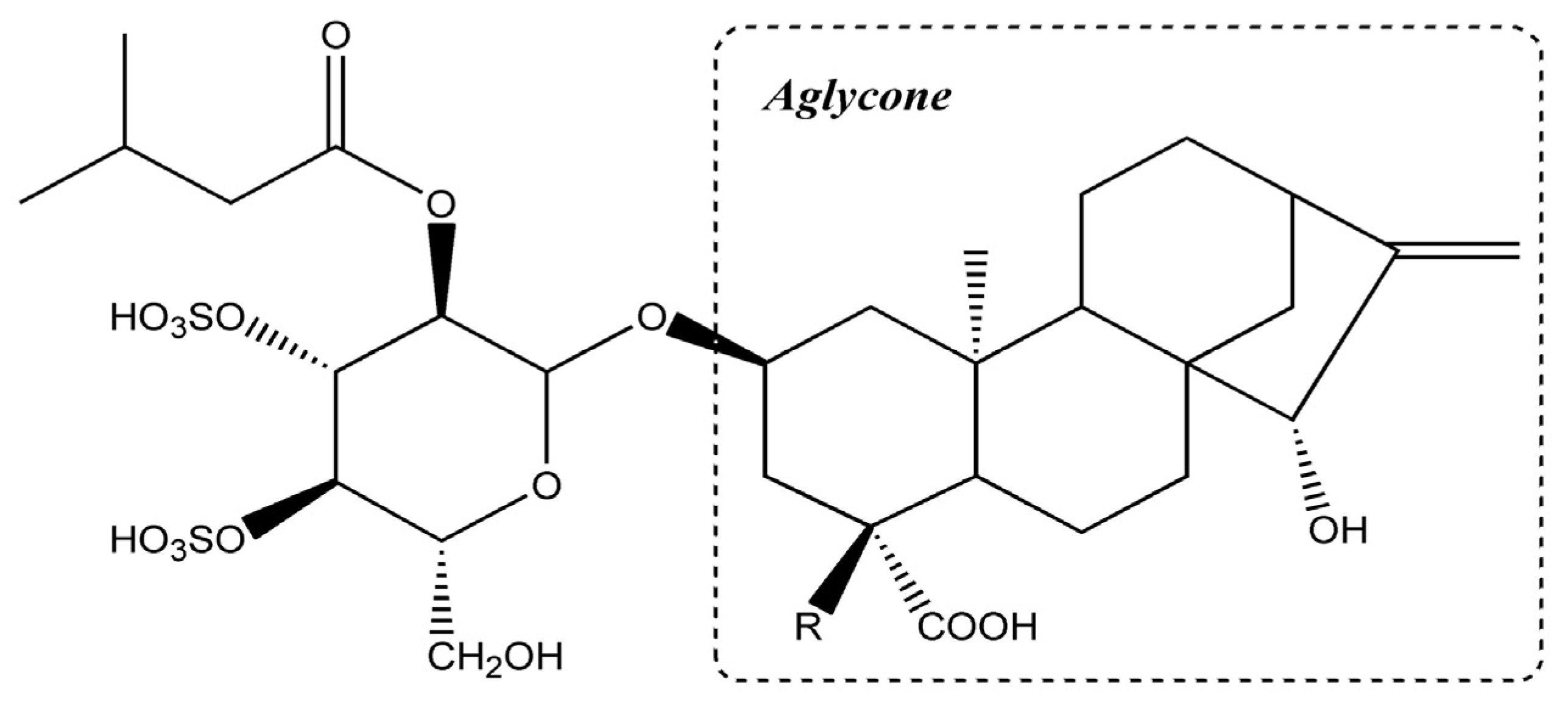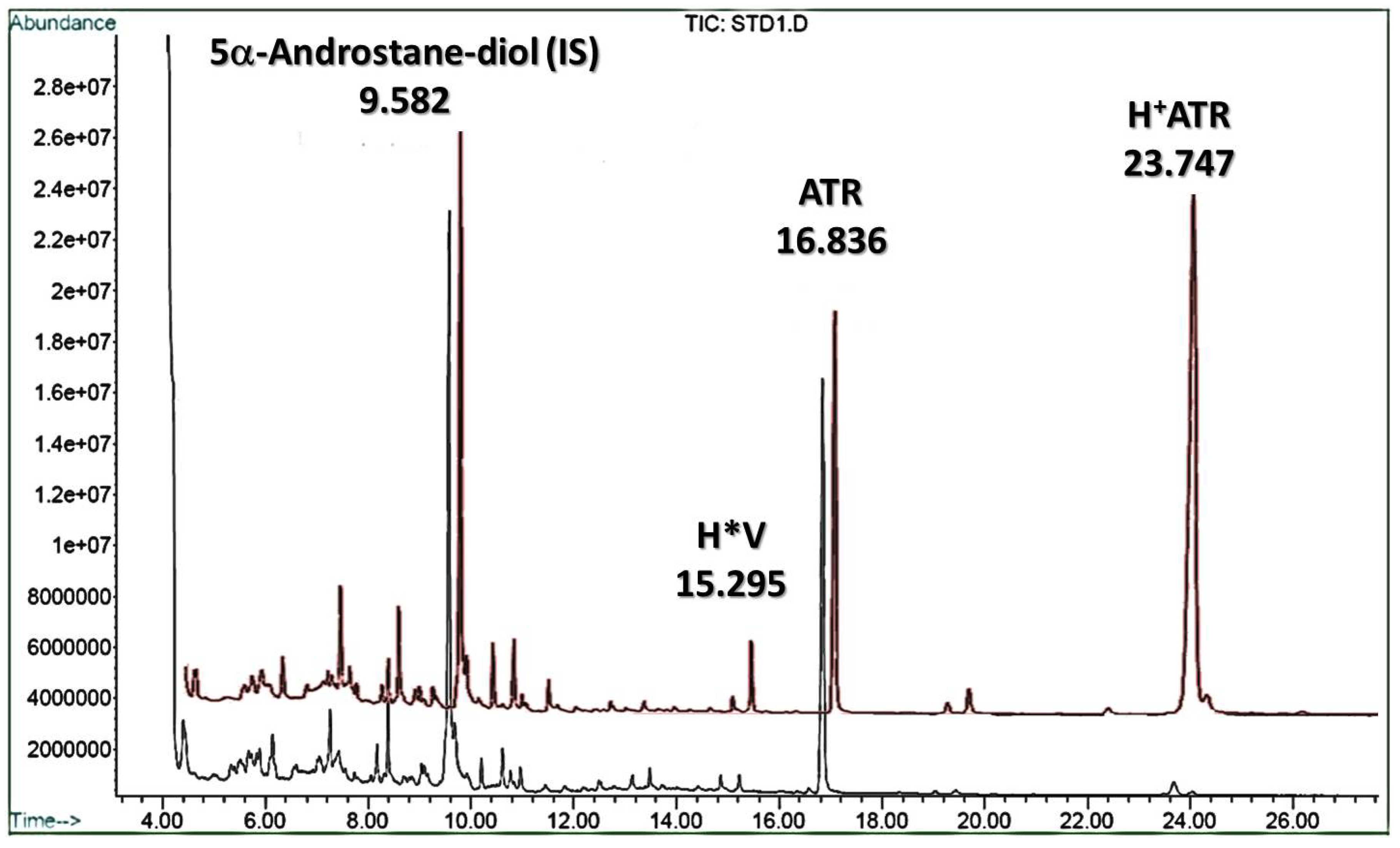The Degradation Mechanism of Toxic Atractyloside in Herbal Medicines by Decoction
Abstract
:1. Introduction
2. Results and Discussion
2.1. Quantitation of ATR in Herbs
2.2. Cytotoxicity of Herb Extracts and Effects of Decoction
2.3. Hydrolysis of ATR and Mass Spectral Interpretations
2.4. Degradation of ATR by Hydrothermal Processing
3. Experimental
3.1. Chemicals, Reagents and Apparatuses
3.2. Sample Preparation and Aqueous Infusion
3.3. MTT Assay
3.4. Stability of ATR during Decoction
3.5. Extraction and GC-MS Analysis
4. Conclusions
Acknowledgments
Conflicts of Interest
References
- Lemasters, J.J.; Sowers, A.E. Phosphate dependence and atractyloside inhibition of mitochondrial oxidative phosphorylation. The ADP-ATP carrier is rate-limiting. J. Biol. Chem. 1979, 254, 1248–1251. [Google Scholar] [PubMed]
- Obatomi, D.K.; Bach, P.H. Biochemistry and toxicology of the diterpenoid glycoside atractyloside. Food Chem. Toxicol. 1998, 36, 335–346. [Google Scholar] [CrossRef]
- Daniele, C.; Dahamna, S.; Firuzi, O.; Sekfali, N.; Saso, L.; Mazzanti, G. Atractylis gummifera L. poisoning: An ethnopharmacological review. J. Ethnopharmacol. 2005, 97, 175–181. [Google Scholar] [CrossRef] [PubMed]
- Cao, H.; Chen, X.; Sun, H.; Sakurai, T.; Zhou, J.; Sun, W.; Lv, H.; Wang, X. Pharmacokinetics-based elucidation on disparity in clinical effectiveness between varieties of Zhi Zhu Wan, a Traditional Chinese Medical formula. J. Ethnopharmacol. 2010, 128, 606–610. [Google Scholar] [CrossRef] [PubMed]
- Meng, H.; Li, G.Y.; Dai, R.H.; Ma, Y.P.; Zhang, K.; Zhang, C.; Li, X.; Wang, J.H. Two new polyacetylenic compounds from Atractylodes chinensis (DC.) Koidz. J. Asian Nat. Prod. Res. 2010, 13, 346–349. [Google Scholar] [CrossRef] [PubMed]
- Han, T.; Zhang, Q.Y.; Zhang, H.; Wen, J.; Wang, Y.; Huang, B.K.; Rahman, K.; Zheng, H.C.; Qin, L.P. Authentication and quantitative analysis on the chemical profile of Xanthium fruit (Cang-Er-Zi) by high-performance liquid chromatography-diode-array detection tandem mass spectrometry method. Anal. Chim. Acta 2009, 634, 272–278. [Google Scholar] [CrossRef] [PubMed]
- Kim, C.K.; Kim, M.; Oh, S.D.; Lee, S.M.; Sun, B.; Choi, G.S.; Kim, S.K.; Bae, H.; Kang, C.; Min, B.I. Effects of Atractylodes macrocephala Koidzumi rhizome on 3T3-L1 adipogenesis and an animal model of obesity. J. Ethnopharmacol. 2011, 137, 396–402. [Google Scholar] [CrossRef] [PubMed]
- Jiang, H.; Shi, J.; Li, Y. Screening for compounds with aromatase inhibiting activities from Atractylodes macrocephala Koidz. Molecules 2011, 16, 3146–3151. [Google Scholar] [CrossRef] [PubMed]
- Lee, J.C.; Lee, K.Y.; Son, Y.O.; Choi, K.C.; Kim, J.; Kim, S.H.; Chung, G.H.; Jang, Y.S. Stimulating effects on mouse splenocytes of glycoproteins from the herbal medicine Atractylodes macrocephala Koidz. Phytomedicine 2007, 14, 390–395. [Google Scholar] [CrossRef] [PubMed]
- Shan, J.J.; Tian, G.Y. Studies on Physico-chemical properties and hypoglycemic activity of complex polysaccharide AMP-B from Atractylodes macrocephala Koidz. Acta Pharm. Sin. 2003, 38, 438–441. [Google Scholar]
- Duan, J.A.; Wang, L.; Qian, S.; Su, S.; Tang, Y. A new cytotoxic prenylated dihydrobenzofuran derivative and other chemical constituents from the rhizomes of Atractylodes lancea DC. Arch. Pharm. Res. 2008, 31, 965–969. [Google Scholar] [CrossRef] [PubMed]
- Wang, H.X.; Liu, C.M.; Liu, Q.; Gao, K. Three types of sesquiterpenes from rhizomes of Atractylodes lancea. Phytochemistry 2008, 69, 2088–2094. [Google Scholar] [CrossRef] [PubMed]
- Stickel, F.; Patsenker, E.; Schuppan, D. Herbal hepatotoxicity. J. Hepatol. 2005, 43, 901–910. [Google Scholar] [CrossRef] [PubMed]
- Bouziri, A.; Hamdi, A.; Menif, K.; Ben Jaballah, N. Hepatorenal injury induced by cutaneous application of Atractylis gummifera L. Clin. Toxicol. (Phila.) 2010, 48, 752–754. [Google Scholar] [CrossRef] [PubMed]
- Haller, C.A.; Dyer, J.E.; Ko, R.; Olson, K.R. Making a diagnosis of herbal-related toxic hepatitis. West. J. Med. 2002, 176, 39–44. [Google Scholar] [CrossRef] [PubMed]
- Cheng, H.M.; Li, C.C.; Chen, C.Y.; Lo, H.Y.; Cheng, W.Y.; Lee, C.H.; Yang, S.Z.; Wu, S.L.; Hsiang, C.Y.; Ho, T.Y. Application of bioactivity database of Chinese herbal medicine on the therapeutic prediction, drug development, and safety evaluation. J. Ethnopharmacol. 2010, 132, 429–437. [Google Scholar] [CrossRef] [PubMed]
- Burns, J.J.; Zhao, L.; Taylor, E.W.; Spelman, K. The influence of traditional herbal formulas on cytokine activity. Toxicology 2010, 278, 140–159. [Google Scholar] [CrossRef] [PubMed]
- Kedrov, A.; Hellawell, A.M.; Klosin, A.; Broadhurst, R.B.; Kunji, E.R.; Muller, D.J. Probing the interactions of carboxy-atractyloside and atractyloside with the yeast mitochondrial ADP/ATP carrier. Structure 2010, 18, 39–46. [Google Scholar] [CrossRef] [PubMed]
- Laurens, J.B.; Bekker, L.C.; Steenkamp, V.; Stewart, M.J. Gas chromatographic-mass spectrometric confirmation of atractyloside in a patient poisoned with Callilepis laureola. J. Chromatogr. B Biomed. Sci. Appl. 2001, 765, 127–133. [Google Scholar] [CrossRef]
- Steenkamp, P.A.; Harding, N.M.; van Heerden, F.R.; van Wyk, B.E. Identification of atractyloside by LC-ESI-MS in alleged herbal poisonings. Forensic Sci. Int. 2006, 163, 81–92. [Google Scholar] [CrossRef] [PubMed]
- Steenkamp, P.A.; Harding, N.M.; van Heerden, F.R.; van Wyk, B.E. Determination of atractyloside in Callilepis laureola using solid-phase extraction and liquid chromatography- atmospheric pressure ionisation mass spectrometry. J. Chromatogr. A 2004, 1058, 153–162. [Google Scholar] [CrossRef]
- Chu, C.; Ho, K.; Hu, A.; Chiu, C.; Wu, H.; Ye, S.; Chen, L. Toxicity attenuation of Atractyloside in traditional Chinese medicinal herbs after hydrothermal processing. Bot. Stud. 2012, 53, 459–465. [Google Scholar]
- Jiang, Y.; David, B.; Tu, P.; Barbin, Y. Recent analytical approaches in quality control of traditional Chinese medicines—A review. Anal. Chim. Acta 2010, 657, 9–18. [Google Scholar] [CrossRef] [PubMed]
- Chau, C.F.; Wu, S.-H. The development of regulations of Chinese herbal medicines for both medicinal and food uses. Trends Food Sci. Technol. 2006, 17, 313–323. [Google Scholar] [CrossRef]
- Buscemi, S.; Rosselli, S.; Bruno, M.; Vivona, N.; Piozzi, F. Photoinduced functionalization of diterpenes: Transformation of the C-20 methyl of atractyligenin into a carbomethoxymethyl or carbamoylmethyl group. J. Photochem. Photobiol. A 2003, 155, 145–149. [Google Scholar] [CrossRef]
- Franje, C.A.; Chang, S.K.; Shyu, C.L.; Davis, J.L.; Lee, Y.W.; Lee, R.J.; Chang, C.C.; Chou, C.C. Differential heat stability of amphenicols characterized by structural degradation, mass spectrometry and antimicrobial activity. J. Pharm. Biomed. Anal. 2010, 53, 869–877. [Google Scholar] [CrossRef] [PubMed]
- Toh, D.F.; New, L.S.; Koh, H.L.; Chan, E.C. Ultra-high performance liquid chromatography/ time-of-flight mass spectrometry (UHPLC/TOFMS) for time-dependent profiling of raw and steamed Panax notoginseng. J. Pharm. Biomed. Anal. 2010, 52, 43–50. [Google Scholar] [CrossRef] [PubMed]
Sample Availability: Samples of the Atractylode lancea, Atractylode macrocephala, Xanthii Fructus are available from the authors. |







| Specimen | ATR ± s.d. (μg/g) a | Reference |
|---|---|---|
| Atractylode lancea (n = 3 | 8980 ± 148 | This study |
| Atractylode macrocephala (n = 3) | 9230 ± 175 | This study |
| Xanthii Fructus (n = 3) | 2570 ± 153 | This study |
| Calliepis laureola | N.D. | [21] |
| Atractylode gummifera | 0.12%–1.57% | [3] |
© 2013 by the authors; licensee MDPI, Basel, Switzerland. This article is an open access article distributed under the terms and conditions of the Creative Commons Attribution license (http://creativecommons.org/licenses/by/3.0/).
Share and Cite
Chen, L.-Y.; Hu, A.; Chang, C.-J. The Degradation Mechanism of Toxic Atractyloside in Herbal Medicines by Decoction. Molecules 2013, 18, 2018-2028. https://doi.org/10.3390/molecules18022018
Chen L-Y, Hu A, Chang C-J. The Degradation Mechanism of Toxic Atractyloside in Herbal Medicines by Decoction. Molecules. 2013; 18(2):2018-2028. https://doi.org/10.3390/molecules18022018
Chicago/Turabian StyleChen, Liang-Yu, Anren Hu, and Chih-Jui Chang. 2013. "The Degradation Mechanism of Toxic Atractyloside in Herbal Medicines by Decoction" Molecules 18, no. 2: 2018-2028. https://doi.org/10.3390/molecules18022018





